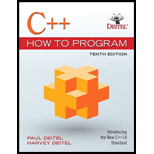
(Write C++ Statements) For each of the following, write C++ statements that perform the
specified task. Assume that unsigned integers are stored in four bytes and that the starting address of the built-in array is at location 1002500 in memory.
a) Declare an unsigned int built-in array values with five elements initialized to the even integers from 2 to 10. Assume that the constant size has been defined as 5.
b) Declare a pointer vPtr that points to an object of type unsigned int.
c) Use a for Statement to display the elements of built-in array values using array sub-Script notation.
d) Write two separate statements that assign the starting address of built-in array values to pointer variable vPtr.
e) Use a for statement to display the elements of built-in array values using pointer/offset notation.
f) Use a for statement to display the elements of built-in array values using pointer/offset notation with the built-in array's name as the pointer.
g) Use a for statement to display the elements of built-in array values by subscripting the pointer to the built-in array.
h) Refer to the fifth element of values using array subscript notation, pointer/offset notation with the built-in array name's as the pointer, pointer subscript notation and pointer/offset notation.
i) What address is referenced by vPtr + 3? What value is stored at that location?
j) Assuming that vPtr points to values [4], what address is referenced by vPtr - = 4? What value is stored at that location?
Want to see the full answer?
Check out a sample textbook solution
Chapter 8 Solutions
C++ How to Program (10th Edition)
- Please solve and answer the questions correctly please. Thank you!!arrow_forwardConsidering the TM example of binary sum ( see attached)do the step-by-step of execution for the binary numbers 1101 and 11. Feel free to use the Formal Language Editor Tool to execute it; Write it down the current state of the tape (including the head position) and indicate the current state of the TM at each step.arrow_forwardI need help on inculding additonal code where I can can do the opposite code of MatLab, where the function of t that I enter becomes the result of F(t), in other words, turning the time-domain f(t) into the frequency-domain function F(s):arrow_forward
 C++ for Engineers and ScientistsComputer ScienceISBN:9781133187844Author:Bronson, Gary J.Publisher:Course Technology Ptr
C++ for Engineers and ScientistsComputer ScienceISBN:9781133187844Author:Bronson, Gary J.Publisher:Course Technology Ptr C++ Programming: From Problem Analysis to Program...Computer ScienceISBN:9781337102087Author:D. S. MalikPublisher:Cengage Learning
C++ Programming: From Problem Analysis to Program...Computer ScienceISBN:9781337102087Author:D. S. MalikPublisher:Cengage Learning Microsoft Visual C#Computer ScienceISBN:9781337102100Author:Joyce, Farrell.Publisher:Cengage Learning,
Microsoft Visual C#Computer ScienceISBN:9781337102100Author:Joyce, Farrell.Publisher:Cengage Learning, Systems ArchitectureComputer ScienceISBN:9781305080195Author:Stephen D. BurdPublisher:Cengage LearningProgramming Logic & Design ComprehensiveComputer ScienceISBN:9781337669405Author:FARRELLPublisher:Cengage
Systems ArchitectureComputer ScienceISBN:9781305080195Author:Stephen D. BurdPublisher:Cengage LearningProgramming Logic & Design ComprehensiveComputer ScienceISBN:9781337669405Author:FARRELLPublisher:Cengage




